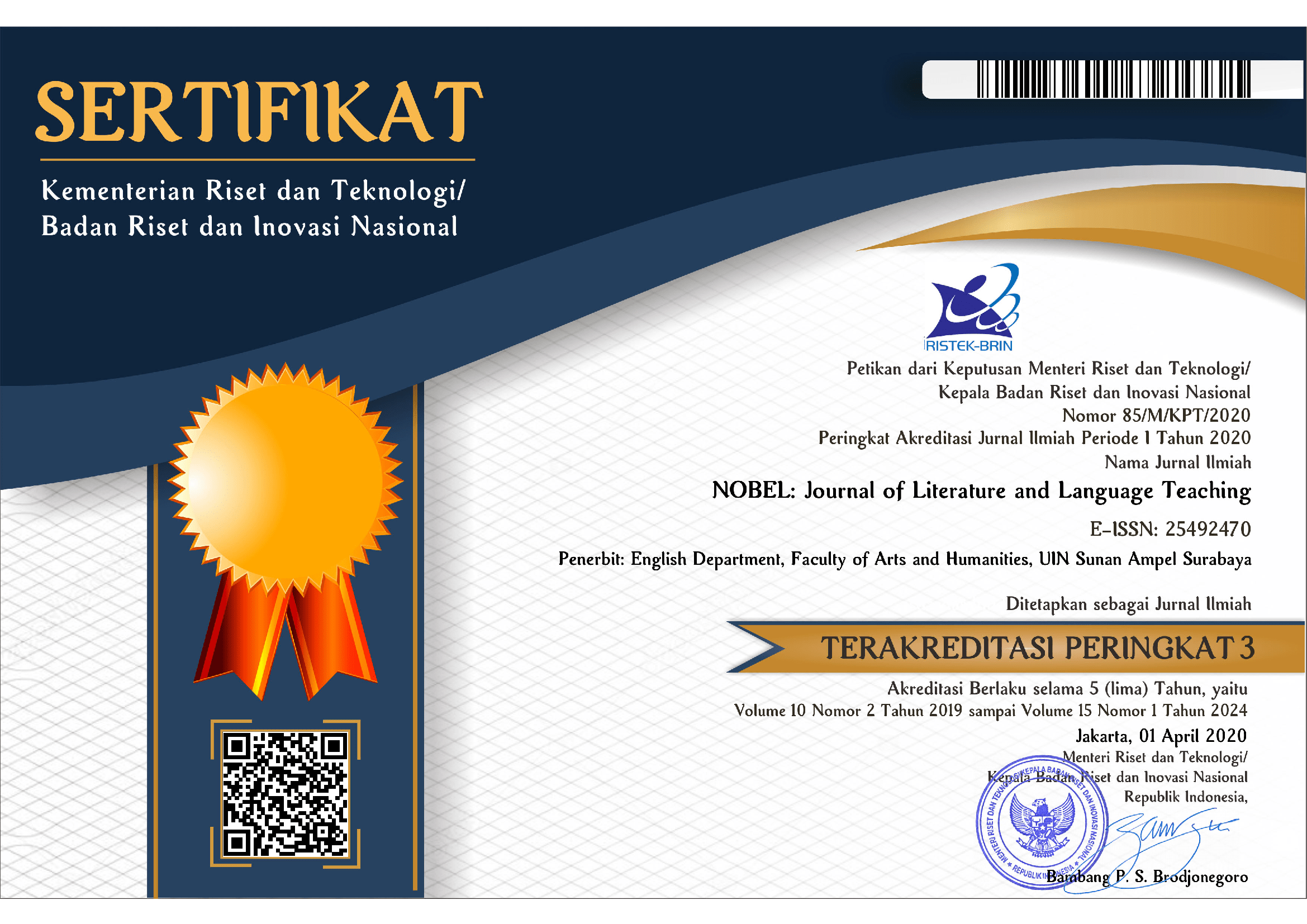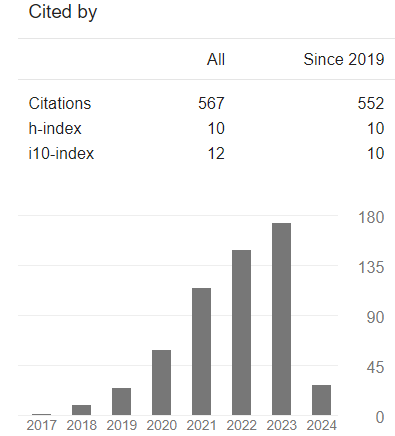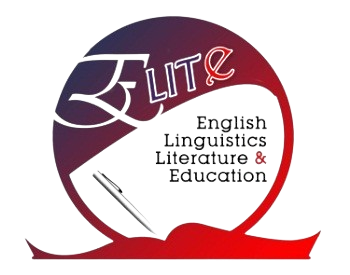Vladimir Propp’s Taxonomic Model of Narrative Functions in Selected Jane Austen’s Novels
DOI:
https://doi.org/10.15642/NOBEL.2023.14.2.164-179Keywords:
fairytale, folktale, Vladimir Propp, narrative functions, Jane AustenAbstract
This research aims to identify the taxonomic model of narrative functions by Vladimir Propp and to find out how these functions are distributed among the dramatis personae (spheres of action) in selected Jane Austen’s novels, they are Pride and Prejudice, Emma, Sense and Sensibility, and Persuasion. This descriptive qualitative research aims to describe the phenomenon and its characteristics. The data were collected qualitatively by documenting, examining, and classifying thoroughly. The results indicate 20 functions in Pride and Prejudice, 14 functions in Emma, 15 functions in Sense and Sensibility, and 22 functions in Persuasion. From the results, this research shows that Jane Austen’s fairytale novels are compatible and match the taxonomic model of narrative functions by Vladimir Propp. The results also show four dramatis personae in each novel (Hero, Villain, Donor, Helper). As for Sense and Sensibility, it has a False Hero. Furthermore, the results share similarities in the 13 functions and the happy endings marriage (W). At the same time, the differences are located in the different number of functions and their distribution, which influence the overall narratives.
Downloads
References
Bacchilega, C., & Rieder, J. (2010). Mixing it up: Generic complexity and gender ideology in early twenty-first century fairy tale films. In P. Greenhill & S. E. Matrix (Eds.), Fairy Tale Films: Visions of Ambiguity (pp. 23–41). https://muse.jhu.edu/pub/187/oa_monograph/chapter/322250/pdf
Barthes, R. (1977). Image, Music, Text. Trans. Stephen Heath. Fontana.
Bronner, S. J. (2007). Meaning of folklore: The analytical essays of Alan Dundes. In S. J. Bronner (Ed.), Meaning of Folklore: The Analytical Essays of Alan Dundes. https://doi.org/10.5860/choice.45-5990
Dogra, S. (2017). The thirty-one functions in Vladimir Propp’s Morphology of the Folktale: An outline and recent trends in the applicability of the Proppian taxonomic model. Rupkatha Journal on Interdisciplinary Studies in Humanities, 9(2), 410–419. https://doi.org/10.21659/rupkatha.v9n2.41
Dundes, A. (1964). The morphology of North American Indian folktales. Folklore Fellows Communications, LXXXI(195), 164–166. https://www.jstor.org/stable/27860675
Gates Jr., H. L., & Tatar, M. (2018). The annotated African American folktales. Liveright Publishing Corporation.
Giolláin, D. (2014). Narratives of nation or progress? Genealogies of European folklore studies. Narrative Culture, 1(1), 71–84. https://doi.org/10.13110/narrcult.1.1.0071
Greimas, A. J. (1987). On meaning: Selected writings in semiotic theory. University of Minnesota Press.
Günay, U. (1993). Application of Propp’s morphological analysis to Turkish folktales. Hacettepe Üniversitesi Edebiyat Fakültesi Dergisi, 10(1), 21–42. https://dergipark.org.tr/en/download/article-file/598028
Haase, D. (1950). The Greenwood encyclopedia of folktales and fairy tales: Volume V. Greenwood Press.
Hammond, S., Pain, H., & Smith, T. J. (2008). Children’s story authoring with Propp’s morphology: An exploratory study. 5th International Conference on Narrative and Interactive Learning Environments, 1–9.
Holsti, O. R. (1969). Content analysis for the social sciences and humanities. Addison-Wesley publishing company. https://doi.org/10.1177/1350507600314007
Kothari, C. R. (2004). Research methodology: Methods and techniques (2nd ed.). New Age International (P) Ltd.
Lahlou, K. (2017). An attempt at applying Vladimir Propp’s morphology of the folktale on Charles Dickens’s Great Expectations. Arab World English Journal For Translation and Literary Studies, 1(3), 106–120. https://doi.org/10.24093/awejtls/vol1no3.8
Lévi-Strauss, C. (1963). Structural anthropology (trans. Claire Jacobson). Basic Books.
McCallum, R. (2000). Approaches to the literary fairy tale. In J. Zipes (Ed.), The Oxford Companion to Fairy Tales: The Western fairy tale tradition from medieval to modern (pp. 17–21). Oxford University Press.
Murphy, T. P. (2015). The fairytale and plot structure. Palgrave Macmillan UK. https://doi.org/10.1057/9781137547088
Neuendorf, K. A. (2002). The content analysis guidebook. SAGE Publications, Inc.
Nurjanah, H., & Shofa, A. H. (2023). A morphological reading of J.K. Rowling’s novels using Propp’s narrative theory. JOLALI: Journal of Language and Literature, 1(1), 25–31. https://doi.org/10.35842/jolali.v1i1.5
Propp, V. (1968). Morphology of the folktale (L. A. Wagner (ed.)). University of Texas Press.
Todorov, T. (1977). The poetics of prose (H. Richard (trans.)). Cornell University Press.
Vučković, D. (2018). A Fairy tale (r)evolution: The value and the critical reading of fairy tales in the contemporary educational context. History of Education & Children’s Literature, XIII(2), 309–336. https://doi.org/10.1400/266699
Wen, W. C., & Wang, S. I. (2021). The narrative structures and representation of homosexuality in Taiwanese BL TV Dramas. Mass Communication Research, 146, 97–143. https://doi.org/10.30386/MCR.202101.0003
Wollen, P. (1969). Signs and meaning in the cinema. Indiana University Press.
Yarlott, W. V. H., & Finlayson, M. A. (2016). ProppML: A complete annotation scheme for Proppian morphologies. Open Access Series in Informatics, 53(8), 1–19. https://doi.org/10.4230/OASIcs.CMN.2016.8
Downloads
Published
How to Cite
Issue
Section
License
Copyright (c) 2023 NOBEL: Journal of Literature and Language Teaching

This work is licensed under a Creative Commons Attribution 4.0 International License.







